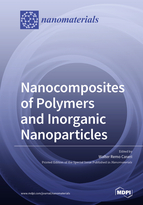Nanocomposites of Polymers and Inorganic Nanoparticles
A special issue of Nanomaterials (ISSN 2079-4991).
Deadline for manuscript submissions: closed (30 June 2019) | Viewed by 52547
Special Issue Editor
Interests: inorganic polymers; organometallic polymers; nanocomposites
Special Issues, Collections and Topics in MDPI journals
Special Issue Information
Dear Colleagues,
Composites of inorganic nanoparticles embedded in a polymer matrix are versatile materials that allow to introduce special properties of nanoparticles into polymer matrix systems. Due to the broad range of polymers and inorganic compounds, a plethora of combinations of these two classes allow reams of variations of characteristics of such nanocomposites. Accordingly, nanocomposites with a diversity of exceptional attributes have been created. Hence, nanocomposites have attracted attention in areas ranging from chemistry, physics or materials science to biology or medicine. Related materials are in the focus of this Special Issue. All types of polymers—not only synthetic but also natural polymers—and the full diversity of inorganic nanoparticles are addressed. As emphasis is put on scientific impact, the nanocomposites and their components should be properly characterized. On the other hand, while the development of products for innovative applications falls in the scope of this Special Issue, routine product optimization of nanocomposites should be considered rather for journals, which focus on industrial rather than on scientific aspects.
Prof. Dr. Walter Remo Caseri
Guest Editor
Manuscript Submission Information
Manuscripts should be submitted online at www.mdpi.com by registering and logging in to this website. Once you are registered, click here to go to the submission form. Manuscripts can be submitted until the deadline. All submissions that pass pre-check are peer-reviewed. Accepted papers will be published continuously in the journal (as soon as accepted) and will be listed together on the special issue website. Research articles, review articles as well as short communications are invited. For planned papers, a title and short abstract (about 100 words) can be sent to the Editorial Office for announcement on this website.
Submitted manuscripts should not have been published previously, nor be under consideration for publication elsewhere (except conference proceedings papers). All manuscripts are thoroughly refereed through a single-blind peer-review process. A guide for authors and other relevant information for submission of manuscripts is available on the Instructions for Authors page. Nanomaterials is an international peer-reviewed open access semimonthly journal published by MDPI.
Please visit the Instructions for Authors page before submitting a manuscript. The Article Processing Charge (APC) for publication in this open access journal is 2900 CHF (Swiss Francs). Submitted papers should be well formatted and use good English. Authors may use MDPI's English editing service prior to publication or during author revisions.
Keywords
- Nanocomposites
- Polymers
- Inorganic nanoparticles
- Materials properties
- Synthesis
- Innovative applications







